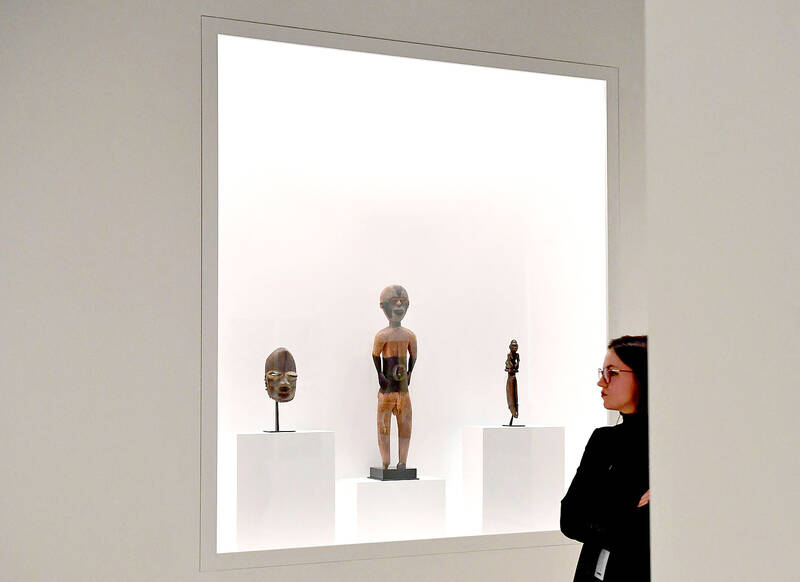The Picasso Museum in Malaga, the southern Spanish city where the artist was born, will opened a new exhibition yesterday which groups his works according to theme instead of by period.
The show — which runs until March 2027 — brings together 141 Pablo Picasso works that the artist kept for himself, including 10 which were never before seen in Spain.
“We have not followed chronology strictly. We do begin with the very early work of Picasso and we end with the last work that he created but within that we often are combining works from different decades,” said the curator of the exhibition, Michael FitzGerald, a professor of art history at Trinity College in the US.

Photo: AFP
“It is a group of works, paintings, sculptures, drawings, prints that represents the entire production of Picasso I hope very accurately. and we particularly emphasised ceramics among them which is a part of Picasso’s work that is often not shown and not perhaps taken as seriously as it should.”
Museums have traditionally displayed works by Picasso grouped according to his key periods, from blue, pink and cubist to surrealist.
Picasso’s great-grandson, Bernard Ruiz-Picasso, said combining works of distinct periods and techniques “allow us to link different moments of his life”.

Photo: AFP
Among the works never exhibited before in Spain is a 1922 painting called “Paul” which depicts the artist’s son as well as the 1933 sculpture Femme accoudeed (1933) and a dish decorated with a bull’s head from the 1950s.
Opened in 2003 in a 16th century mansion, Malaga’s Picasso Museum is located just a couple of hundred meters from the house where the artist was born in 1881.
Picasso left for Paris in 1904 and most of his adult years were spent in France where he died in 1973. The Picasso Museum in the French capital houses the world’s biggest collection of the artist’s works.

One of the biggest sore spots in Taiwan’s historical friendship with the US came in 1979 when US president Jimmy Carter broke off formal diplomatic relations with Taiwan’s Republic of China (ROC) government so that the US could establish relations with the People’s Republic of China (PRC). Taiwan’s derecognition came purely at China’s insistence, and the US took the deal. Retired American diplomat John Tkacik, who for almost decade surrounding that schism, from 1974 to 1982, worked in embassies in Taipei and Beijing and at the Taiwan Desk in Washington DC, recently argued in the Taipei Times that “President Carter’s derecognition

This year will go down in the history books. Taiwan faces enormous turmoil and uncertainty in the coming months. Which political parties are in a good position to handle big changes? All of the main parties are beset with challenges. Taking stock, this column examined the Taiwan People’s Party (TPP) (“Huang Kuo-chang’s choking the life out of the TPP,” May 28, page 12), the Democratic Progressive Party (DPP) (“Challenges amid choppy waters for the DPP,” June 14, page 12) and the Chinese Nationalist Party (KMT) (“KMT struggles to seize opportunities as ‘interesting times’ loom,” June 20, page 11). Times like these can

Dr. Y. Tony Yang, Associate Dean of Health Policy and Population Science at George Washington University, argued last week in a piece for the Taipei Times about former president Ma Ying-jeou (馬英九) leading a student delegation to the People’s Republic of China (PRC) that, “The real question is not whether Ma’s visit helps or hurts Taiwan — it is why Taiwan lacks a sophisticated, multi-track approach to one of the most complex geopolitical relationships in the world” (“Ma’s Visit, DPP’s Blind Spot,” June 18, page 8). Yang contends that the Democratic Progressive Party (DPP) has a blind spot: “By treating any

You can tell a lot about a generation from the contents of their cool box: nowadays the barbecue ice bucket is likely to be filled with hard seltzers, non-alcoholic beers and fluorescent BuzzBallz — a particular favorite among Gen Z. Two decades ago, it was WKD, Bacardi Breezers and the odd Smirnoff Ice bobbing in a puddle of melted ice. And while nostalgia may have brought back some alcopops, the new wave of ready-to-drink (RTD) options look and taste noticeably different. It is not just the drinks that have changed, but drinking habits too, driven in part by more health-conscious consumers and